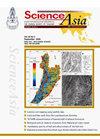Archidendron jiringa seed peel extract in the removal of lead from synthetic residual water using coagulation-flocculation process
IF 0.6
4区 综合性期刊
Q3 MULTIDISCIPLINARY SCIENCES
引用次数: 1
Abstract
: Archidendron jiringa seed peel extract was used to aid the coagulation-flocculation process to ultimately remove lead from synthetic residual water. The effectiveness of this method was studied to obtain an alternative approach that is easy to be handled with low cost and energy in removing the lead from residual water. Optimum parameters were analyzed to determine the effectiveness of lead removal, including pH, alum dose, and A. jiringa seed peel extract dose. A study on the coagulation-flocculation process with and without the aid of A. jiringa was also conducted. The optimum pH, the alum dose, and the A. jiringa seed peel extract dose were 9.0, 2.44 g / l, and 60.2 mg / l, respectively. The percentage of lead removal with the aid of A. jiringa seed peel extract was 79%, and the percentage was dropped to only 47% without the extract. A significantly higher rate in the coagulation-flocculation process due to the presence of A. jiringa seed peel extract proved its effectiveness in removing lead from wastewater.鹅掌楸籽皮提取物混凝絮凝法去除合成废水中的铅
:采用鸡苓籽皮提取物辅助混凝-絮凝工艺,最终去除合成残水中的铅。研究了该方法的有效性,以获得一种易于操作、低成本、低能耗的除铅方法。通过对pH、明矾用量、木林子皮提取物用量等参数的分析,确定了木林子皮提取物对铅的去除效果。并对加、不加牛蒡的混凝-絮凝过程进行了研究。最适pH为9.0 g / l,明矾用量为2.44 g / l,木参籽皮提取物用量为60.2 mg / l。加枸杞籽皮提取物对铅的去除率为79%,不加枸杞籽皮提取物的去除率仅为47%。在混凝-絮凝过程中,栀子皮提取物的去除率显著提高,证明了其对废水中铅的去除效果。
本文章由计算机程序翻译,如有差异,请以英文原文为准。
求助全文
约1分钟内获得全文
求助全文
来源期刊

Scienceasia
MULTIDISCIPLINARY SCIENCES-
CiteScore
1.70
自引率
33.30%
发文量
102
审稿时长
1 months
期刊介绍:
ScienceAsia is a multidisciplinary journal publishing papers of high quality bimonthly, in printed and electronic versions, by the Science Society of Thailand under Royal Patronage and the National Research Council of Thailand. The journal publishes original research papers that provide novel findings and important contribution to broad area in science and mathematics. Areas covered include Biological Sciences and Biotechnology, Chemistry and Material Sciences, Environmental and Applied Sciences, and Mathematics and Physical Sciences. Manuscripts may report scientifically useful data, observations or model predictions, and/or provide a new scientific concept or a new explanation of published results. Submissions of materials of current scientific interest are highly welcome, provided that there is sufficient scientific merit. The journal will not accept manuscripts which have been published or are being considered for publication elsewhere, nor should manuscripts being considered by ScienceAsia be submitted to other journals. Submitted manuscripts must conform to the guidelines given in the Instructions for Authors
 求助内容:
求助内容: 应助结果提醒方式:
应助结果提醒方式:


